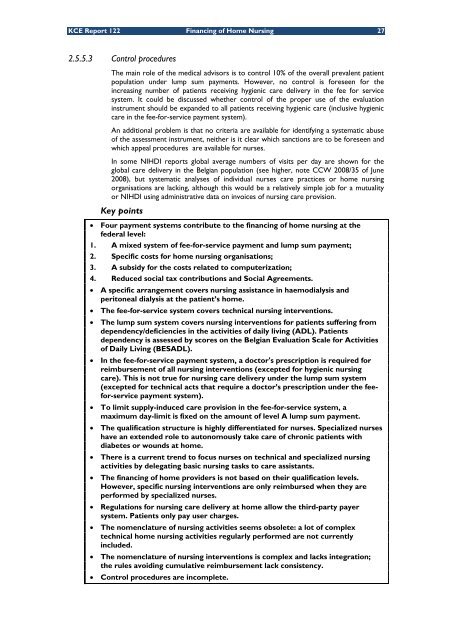Le financement des soins infirmiers à domicile en Belgique - KCE
Le financement des soins infirmiers à domicile en Belgique - KCE
Le financement des soins infirmiers à domicile en Belgique - KCE
You also want an ePaper? Increase the reach of your titles
YUMPU automatically turns print PDFs into web optimized ePapers that Google loves.
<strong>KCE</strong> Report 122 Financing of Home Nursing 27<br />
2.5.5.3 Control procedures<br />
The main role of the medical advisors is to control 10% of the overall preval<strong>en</strong>t pati<strong>en</strong>t<br />
population under lump sum paym<strong>en</strong>ts. However, no control is forese<strong>en</strong> for the<br />
increasing number of pati<strong>en</strong>ts receiving hygi<strong>en</strong>ic care delivery in the fee for service<br />
system. It could be discussed whether control of the proper use of the evaluation<br />
instrum<strong>en</strong>t should be expanded to all pati<strong>en</strong>ts receiving hygi<strong>en</strong>ic care (inclusive hygi<strong>en</strong>ic<br />
care in the fee-for-service paym<strong>en</strong>t system).<br />
An additional problem is that no criteria are available for id<strong>en</strong>tifying a systematic abuse<br />
of the assessm<strong>en</strong>t instrum<strong>en</strong>t, neither is it clear which sanctions are to be forese<strong>en</strong> and<br />
which appeal procedures are available for nurses.<br />
In some NIHDI reports global average numbers of visits per day are shown for the<br />
global care delivery in the Belgian population (see higher, note CCW 2008/35 of June<br />
2008), but systematic analyses of individual nurses care practices or home nursing<br />
organisations are lacking, although this would be a relatively simple job for a mutuality<br />
or NIHDI using administrative data on invoices of nursing care provision.<br />
Key points<br />
• Four paym<strong>en</strong>t systems contribute to the financing of home nursing at the<br />
federal level:<br />
1. A mixed system of fee-for-service paym<strong>en</strong>t and lump sum paym<strong>en</strong>t;<br />
2. Specific costs for home nursing organisations;<br />
3. A subsidy for the costs related to computerization;<br />
4. Reduced social tax contributions and Social Agreem<strong>en</strong>ts.<br />
• A specific arrangem<strong>en</strong>t covers nursing assistance in haemodialysis and<br />
peritoneal dialysis at the pati<strong>en</strong>t’s home.<br />
• The fee-for-service system covers technical nursing interv<strong>en</strong>tions.<br />
• The lump sum system covers nursing interv<strong>en</strong>tions for pati<strong>en</strong>ts suffering from<br />
dep<strong>en</strong>d<strong>en</strong>cy/defici<strong>en</strong>cies in the activities of daily living (ADL). Pati<strong>en</strong>ts<br />
dep<strong>en</strong>d<strong>en</strong>cy is assessed by scores on the Belgian Evaluation Scale for Activities<br />
of Daily Living (BESADL).<br />
• In the fee-for-service paym<strong>en</strong>t system, a doctor's prescription is required for<br />
reimbursem<strong>en</strong>t of all nursing interv<strong>en</strong>tions (excepted for hygi<strong>en</strong>ic nursing<br />
care). This is not true for nursing care delivery under the lump sum system<br />
(excepted for technical acts that require a doctor’s prescription under the feefor-service<br />
paym<strong>en</strong>t system).<br />
• To limit supply-induced care provision in the fee-for-service system, a<br />
maximum day-limit is fixed on the amount of level A lump sum paym<strong>en</strong>t.<br />
• The qualification structure is highly differ<strong>en</strong>tiated for nurses. Specialized nurses<br />
have an ext<strong>en</strong>ded role to autonomously take care of chronic pati<strong>en</strong>ts with<br />
diabetes or wounds at home.<br />
• There is a curr<strong>en</strong>t tr<strong>en</strong>d to focus nurses on technical and specialized nursing<br />
activities by delegating basic nursing tasks to care assistants.<br />
• The financing of home providers is not based on their qualification levels.<br />
However, specific nursing interv<strong>en</strong>tions are only reimbursed wh<strong>en</strong> they are<br />
performed by specialized nurses.<br />
• Regulations for nursing care delivery at home allow the third-party payer<br />
system. Pati<strong>en</strong>ts only pay user charges.<br />
• The nom<strong>en</strong>clature of nursing activities seems obsolete: a lot of complex<br />
technical home nursing activities regularly performed are not curr<strong>en</strong>tly<br />
included.<br />
• The nom<strong>en</strong>clature of nursing interv<strong>en</strong>tions is complex and lacks integration;<br />
the rules avoiding cumulative reimbursem<strong>en</strong>t lack consist<strong>en</strong>cy.<br />
• Control procedures are incomplete.

















